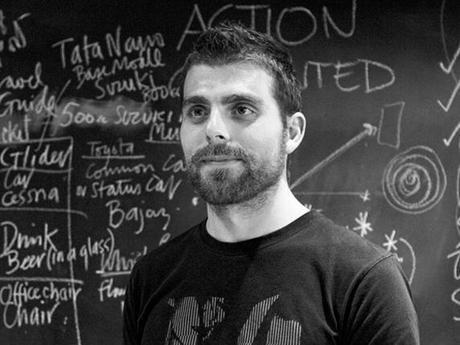I read an article on the web the other day that suggested that the Internet is making people stupid. It went along the lines of how our front cortex is changing due to the nature of our information aggregation — in essence we are doing quick dives into material and following a shallower form of reading rather than going deeper. It would seem that an evolution step change has occurred. We live in a culture of instantaneous everything, social media, blogs, texting and the way we gather from the mass of information on the web, causing us to power browse to get the bare essentials. Now I’m pretty sure it went something like that, but you know, I only had time to skim read it before facebook beckoned.
So with people getting thicker, what are the implications for our industry and designers in particular? Well, to put it bluntly I would assume that designers are indeed, a little less brighter, the majority more akin to a dim glow. It isn’t like every designer hasn’t faced such criticism before. Our natural tendency to create rather than prescribe; Solve problems as opposed to counting numbers; look at pictures rather than read the text. These nuances haven’t helped our struggle for Intelligence equality.
I’d also like to point out that calling people stupid isn’t something I like to do on a daily basis, although I’m not completely immune to doing so. What does stupid mean anyway? Look how successful Forest Gump turned out, for instance, or the ex-president of the United States of America.
So as studios and agencies become herding pens for sheep, what can our clients begin to expect? Well for a start, all their problems no matter how sophisticated, can all be neatly skinned in a visual system or look just like anything you see on a website, blog, or portfolio site. For those who have already lost the power of Google searching, that would be ffffound.com, behance.net, the dieline.com and thecoolhunter.com. It’s a wonderful solution – design in an instant, all spic and span, saving time and money, and most importantly, saving some of those brain cells from exerting any effort.
You see that’s the real problem. If designers don’t need to think anymore, then the basis for our profession, problem solving, is null and void. Increased pressures for studios over the past few years have resulted in lower fees and shorter timelines, so when backed against the wall without an idea in sight, hand someone a weapon, and they’ll no doubt use it. Do that a few times, and pretty soon you’ve got serial usage, and a reliance on other peoples work as your answers.
I was struck on the weekend by a revelation, which should have probably occurred many years earlier. As I looked back on all the designers I’ve worked with, I realized that the exceptional ones that stood out, didn’t just sit under a banner of creativity, but had something far greater. They had intelligence. Mensa IQ’s. Their ancient ancestor was probably akin to the ape with the bone in 2001: A space odyssey. I’ll go a step further and call them inquisitive and curious, the drivers of knowledge acquirement, and the keys to original design thinking.
These smart designers delve deep, search for meaning, discover hidden and lateral paths, and above all, push themselves to search further. It’s how you end up with design that is new, and not simply imitation. Chatting to Russ Meyer, the Global head of strategy for Landor Associates, he pointed out “I look for curiosity above all else in future hires. Everything else can be learned, but without this drive, I’m not interested.”
Smart designers are easy to spot. For a start they’re intrigued by words, not just pictures. This means they won’t simply use Lorem Ipsum in all their headlines with the thought that it will get written once the client has selected an idea. The copywriting will be half of the idea. They also use spell check as a normal tool in their repertoire rather than see it as a strange phrase that does not compute. Ask a designer you know, what was the last design book they read. Clarify that you mean by reading, and not just looking through a book, and you’ll be surprised, or not, at how many have yet to advance beyond mere picture books.
I guess the most obvious signs, are the stories they tell through their work. I’ve seen many a designer simply describe what’s on the page, hoping you’ll see more than they did, while the clever clogs designer will articulate the reason for its existence, not that the work will usually need explaining anyway.
The work of these designers is head and shoulders above the usual. These are the designers that have a place in the D&AD history books, and often within the writing for design section. They are the architects of engaging and original branding, the builders of emotional ties with products, organizations and corporations, with a thorough understanding of communication in all its guises. Last but not least, they are the new leaders within our industry – the next wave of designers and young creative directors, already challenging the status quo, generating ideas beyond the boundaries of today, innovating in new and emerging mediums, and always looking forward to a better way of doing things.
So the next time you’re meeting, interviewing, or working with a designer, don’t assume that what you see on the page is a clear sign of a good designer. Search beyond the immediate visual display, delve deeper, and take the time to really understand the work and the person in front of you. If you’re not willing or able spot the difference between clever design and copycat graphics, a thinker and a visualiser, the future and the past, then that’s your own stupidity.

Having served as creative director of Landor Associates in Sydney, I now lead the Paris office. Driving the overall creative vision of the studio is my focus.
My approach to design is deliberate, strategic and impactful, and ideally a bit unexpected. My commitment to the education and growth of my team, clients and the industry is unwavering.
I hold a BA in architecture from Edinburgh College of Art in the United Kingdom. My work has consistently received numerous awards including accolades from D&AD, NY Type Directors Club, Tokyo Type Directors Club, Graphis, Wolda, Communication Arts, The One Show, AIGA, AGDA and has been featured in design publications and exhibitions throughout the world.
I regularly lecture, write on design and branding related subjects and I’m also a foreign correspondent for Desktop magazine.
Article originally published in Desktop Magazine, November 2010. www.desktopmag.com.au
Contributed to VSUAL by Jason Little and republished ‘as it is’ in August 2011.
Creative Director, Landor Associates
Location: Paris, France
URL: www.jasonlittle.co
Follow jaslittle

